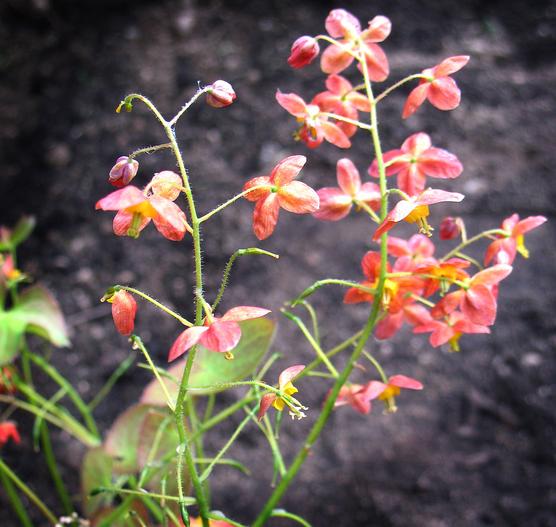Bishop’s Hat
(Epimedium ×warleyense)
Bishop’s Hat (Epimedium ×warleyense)
/
/

Sonya
CC BY-SA 2.0
Image By:
Sonya
Recorded By:
Copyright:
CC BY-SA 2.0
Copyright Notice:
Photo by: Sonya | License Type: CC BY-SA 2.0 | License URL: https://creativecommons.org/licenses/by-sa/2.0/ | Uploader: sonyaseattle | Publisher: Flickr













Estimated Native Range
Summary
Epimedium ×warleyense, commonly known as Bishop’s Hat, is an evergreen perennial herb that originated from a cross between E. alpinum and E. pinnatum subsp. colchicum. It is not naturally occurring in the wild but has characteristics that suggest it would thrive in forest understories or shaded rock gardens. This plant typically grows to a height and width of 0.8-1 feet (0.2-0.3 meters), forming a dense, ground-hugging clump. The foliage is heart-shaped with a leathery texture, and in some cultivars, it may turn red in the fall. Bishop’s Hat produces a profusion of delicate flowers in the spring, with colors ranging from yellow to orange, and some with a red or brown tinge, which hover above the foliage on wiry stems.
Bishop’s Hat is valued for its drought tolerance once established, its resistance to deer, and its ability to thrive in dry shade, where few other plants can compete. It is often used as ground cover, in woodland gardens, or in shaded border fronts. It prefers part shade to full shade and requires well-drained soil with a neutral to slightly acidic pH. While it tolerates a range of soil types, it performs best in humus-rich soil. Regular watering is necessary, especially in dry conditions, but it is relatively low-maintenance once established. There are no serious insect or disease problems, but watch for vine weevils and leaf spot.CC BY-SA 4.0
Bishop’s Hat is valued for its drought tolerance once established, its resistance to deer, and its ability to thrive in dry shade, where few other plants can compete. It is often used as ground cover, in woodland gardens, or in shaded border fronts. It prefers part shade to full shade and requires well-drained soil with a neutral to slightly acidic pH. While it tolerates a range of soil types, it performs best in humus-rich soil. Regular watering is necessary, especially in dry conditions, but it is relatively low-maintenance once established. There are no serious insect or disease problems, but watch for vine weevils and leaf spot.CC BY-SA 4.0
Plant Description
- Plant Type: Herb
- Height: 0.8-1 feet
- Width: 0.8-1 feet
- Growth Rate: Moderate
- Flower Color: Orange, Yellow
- Flowering Season: Spring
- Leaf Retention: Evergreen
Growth Requirements
- Sun: Part Shade, Full Shade
- Water: Low, Medium
- Drainage: Medium
Common Uses
Bank Stabilization, Bee Garden, Deer Resistant, Drought Tolerant, Erosion Control, Groundcover, Low Maintenance, Rabbit Resistant
Natural Habitat
Forest understories or shaded rock gardens
Other Names
Common Names: Barrenwort , Fairy Wings , Horny Goat Weed , Rowdy Lamb Herb , Randy Beef Grass , Yin Yang Huo
Scientific Names: Epimedium ×warleyense
GBIF Accepted Name: Epimedium ×warleyense Stearn